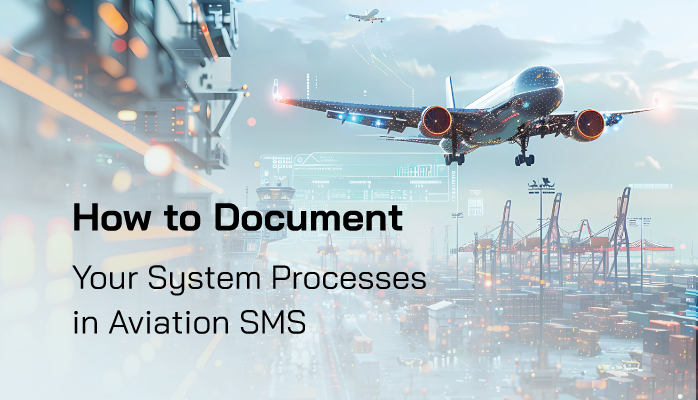What Is a System in Aviation SMS

First of all, a system is simply a logical, separate part or "entity" within the overall scope of your company that includes things like:
- Its own set of procedures, tasks, etc.
- Its own set of requirements, roles, personnel; and
- Its own set of identified hazards, associated risks, and risk control strategies.
Your company will have many systems. For example, an airline might have systems for:
- Flight Ops;
- Ground Ops;
- Maintenance;
- And so on.
Related Articles on Aviation Hazards, Risks and Controls
- Difference Between Hazards, Risks & Control Measures in Aviation SMS
- How to Identify Hazards and Assess Risks in Aviation SMS Programs - With Free Resources
- 5 Tips Reviewing Hazards, Risks & Controls in Aviation SMS - With Examples
Each of these is a separate, distinct entity within the airline. This being said, not all systems are created equal. Furthermore, some parts of a system will be more important than others. These high-priority systems are critical for evaluating the success of the organization's mission, whether their main goals are to:
- Make a profit;
- Provide supporting services, such at airports and regulatory authorities;
- Protect the environment; or
- Make the world a "better, safer" place, such as UN flight operations.
Logically, one can easily reason that the majority of an aviation service provider's risk management processes are focused on protecting the service provider's mission, even when their mission conflicts with safe operations. Due to the conflicting demands, the aviation industry has determined the need for change to ensure operators are not neglecting safety in favor of satisfying their primary mission. This change has turned into the formal processes of managing safety through the implementation of aviation safety management systems (SMS).
Instead of trying to come up with what I think the objectives are of the SMS, I prefer to use the FAA's rationale:
The objective of Safety Management Systems (SMS) is to proactively manage safety, to identify potential hazards, to determine risk, and to implement measures that mitigate the risk. The FAA envisions operators being able to use all of the components of SMS to enhance a carrier’s ability to identify safety issues and spot trends before they result in a near-miss, incident, or accident. For this reason, the FAA is requiring carriers to develop and implement an SMS.
Source: Federal Register / Vol. 80, No. 5 / Thursday, January 8, 2015 / Rules and Regulations - emphasis added.
I like to sum this up in fewer words and say: The purpose of SMS is to stop "The Accident" that we all know is coming, but we don't know when, where, how, or to whom. But we do know why "The Accident" will occur.
By implementing an SMS, aviation service providers will have fully implemented proven risk management processes that are effective in stopping "The Accident." As I stated before, the operator has historically worked on processes to further their core mission at the expense of assuring the public of a safe "system" that we know as the aviation industry.
Based on the organization's mission, there will be internal systems that are most important in achieving organizational goals. For example, in an airline, the most important system is "Flight Operations." We call the important systems “crucial systems.” Crucial systems are systems or parts of systems that have the greatest influence over mission performance and subsequently tend to have the greatest risk. For example, many parts of a Flight Ops system will inherently have much more bearing on mission risk than most parts of a Ground Ops system.
Related Articles on Aviation Risk Management
- What Is the Process of Risk Management in Aviation SMS
- 3 Main Components of Aviation Risk Management
- Difference Between Reactive, Predictive and Proactive Risk Management in Aviation SMS
What Does It Mean to Document Your System in SMS?

Documenting your systems means:
- Thoroughly analyzing all safety aspects of a system;
- Documenting all resources, such as controls, procedures, policies, technology, etc. in that system;
- Documenting all identified hazards and risks associated with operations within that system; and
- Documenting high-level expectations for how the system will operate.
Documenting your systems in your aviation SMS, simply put, is putting your SMS on paper.
Purpose of Documenting Your System Processes
The reason for documenting your system processes, is, as said, to encapsulate your SMS on paper, thus making it easier to control. In the FAA, the purpose of the Safety Risk Management process is to document your systems.
There are two important questions you need to ask about documenting systems' processes:
- Why is this important?
- What is the goal and purpose of doing this?
Two problems commonly arise in relation to these questions. Organizations don’t know why they are documenting their systems, and so they provide poor or inaccurate documentation of their systems. The other danger is that documenting systems is a huge task and it’s easy to “get lost in the weeds.”
In either case, the result is poorly or inaccurately documented systems. The reason documenting systems is important, and the goals behind doing it, are:
- Demonstrate you have thorough knowledge about your operating environments (systems);
- Envision a plan for how your organization will safely navigate these operating environments (systems);
- Account for all of how you will mitigate safety concerns, including what you will use to mitigate and how you will mitigate; and
- Document all of the concerns you are actively mitigating, such as hazards and risks.
When you document your system processes, everything you document should fulfill one of the above criteria.
What Should You Document About Your System Processes
When documenting the systems of your aviation SMS, you should especially take care to document things like:
- All identified hazards for the system;
- Associated risk consequences for the system;
- Each risk control, including how it works to control the risk;
- Regular or periodic performance monitoring practices you will use to mitigate safety concerns, such as inspections, audits, etc.
- Policies and procedures that affect system safety;
- Other practices you will use to mitigate risk, such as job checklists, issue management processes, etc.
- Goals and objectives related to the system; and
- Relevant tools, software, hardware, machinery, and other technology you will use to mitigate risk.
- Relevant tools and processes to monitor the safety performance of the systems.
Related Articles on SMS Documentation
- What Are SMS Documentation Requirements?
- Best Practices for Documenting Your Aviation SMS
- 5 Times When Documentation Saves an Aviation Safety Manager
Tips for Documenting Your System Processes

A couple of tips for documenting your system processes are:
- Use a template, such as 5M model or SHELL model, to document;
- Be very thorough, but ensure that your documentation only contains documentation related to elements of the system that affect safety;
- Update your system processes every time new changes or new observations are made related to the system; and
- Make sure your system process documentation reflects how safety is actually mitigated in practice.
The last point is especially important because if your system process does not describe how the system actually functions, your documentation is worthless. Furthermore, it could land you in serious trouble if you are audited or if your company goes to court regarding a safety issue.
Being thorough seems to be a very vague blanket statement. Thorough documentation benefits the accountable executive who is responsible for the system, but many others stand to benefit from your documentation efforts, including:
- New department heads needing an understanding of your systems;
- Safety teams reviewing this information to understand the system and the extent of implemented risk controls during their risk management processes;
- Auditors who need documentation to evaluate your processes.
These are simply quick examples, but you can see how easily it becomes apparent that without adequate documentation, your SMS is doomed. For example, when the auditor comes to review your processes, if they can find no evidence of particular risk management activity, they have no choice but to issue the finding. In short, if it isn't documented, it didn't happen, as we hear repeatedly as conversations turn to audit SMS.
Related Articles on Aviation SMS Auditing
- Real Difference Between an Aviation Safety Audit vs. Inspection
- Aviation Safety Audit Preparation - 4 Free SMS Audit Checklist Templates
- How to Create an Aviation SMS Audit Plan
How to Review Quality of System Process Documentation
Reviewing the quality of system process documentation is a matter of assessing how closely your system process documentation reflects actual operations.
- Are the controls you documented functioning as described?
- Are all controls described in your system process active?
- Are all resources being used included in your documentation?
- Are all resources documented actually being used?
- Are the processes you document performing in the same order and with the same results as documented?
- Do you have a log of the review history for each process?
Final Thoughts on Documenting System Processes

By now, you are probably wondering, where do I start? System documentation requires considerable effort and you will not complete it overnight. SMS is a structured process. Period. System documentation that captures all your risk management strategies and processes is a huge undertaking because there are so many moving parts to assess, analyze, and yes, document.
Aviation systems are not closed systems, but open systems. This means that you will also need to account for environmental factors affecting your operations, such as:
- Economic;
- Political instability;
- Technological advances; and
- The various human groups interacting with the system.
When I first saw the SMS requirements for systems analysis and documenting the systems, I cringed internally. My background as an IT data management expert understood the potential scope of identifying and documenting all the systems within a complex airline, airport, or large aviation maintenance organization. For a couple of years, I cringed and avoided this because I really didn't know what to expect. There was scant documentation available to guide and advise me of not only "detailed" requirements, but also the expectations.
We have all heard that SMS documentation should correlate with the complexity of the organization. What the hell does this really mean to a new safety manager assigned this seemingly monumental task?
Documenting system processes is like eating an elephant...one bite at a time.
To get started, the best advice I can give you is to start by simply describing the system. For each system, write a short narrative that answers these questions:
- What is it that we do?
- What do we do it with?
- Where do we do it?
- Who do we do it with?
- When do we do it?
This is an excellent starting point and is designed to trigger your thought processes. Need one final tip? After your system description, use one of the recommended tools mentioned previously, either the 5M model or SHELL model.
If you need help with this, we provide SMS database software to help you manage your SMS documentation. To be completely transparent, the SMS database software is designed to manage all SMS requirements and not simply the SMS documentation, which is a small, but critical part of your aviation SMS.
Good luck. If you need help, sign up for a free demo.
On Demand SMS Database Demo Videos
Prefer to watch demo videos instead of signing up for a live demo? These short demo videos take you through the highlights of this SMS database software.
Last updated July 2025.






